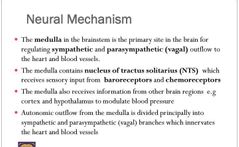![]()
![]()
![]()
Use LEFT and RIGHT arrow keys to navigate between flashcards;
Use UP and DOWN arrow keys to flip the card;
H to show hint;
A reads text to speech;
23 Cards in this Set
- Front
- Back
|
The mechanisms for regulation of blood pressure include; |
Neural Mechanism Renal mechanism Humoral Mechanism |
|
|
_________ mechanism refers to regulation of the blood pressure by the nervous system. |
Neural |
|
|
The __________ mechanism is for short term blood pressure control |
Neural |
|
|
Components of the Neural Mechanisms includes; |

Brain Cortex & Hypothalamus Brain stem: Medulla
Receptors Baroreceptorscarotid - sinus & aortic arch Chemoreceptors - carotid body & aortic body
Autonomic nerves Sympathetic fibres Parasympathetic fibres |
|
|
Write White note in the neural mechanism of the Blood pressure regulation |

Done |
|
|
The vasomotor centre is located in the medulla. It consists of three areas; |
Sensory area : Nucleus of tractus solitarius/solitary tract; which inhibits/stimulates the vasocontrictor or vasodilator area depending on blood pressure signal received from the baroreceptors or chemoreceptors. Vasoconstrictor area: the pressor or cardioaccelerator area and is located in the lateral portion of vasomotor centre. Its stimulation causes vasoconstriction Vasodilator area: the depressor or cardioinhibitory area and is located in the medial portion of vasomotor centre. Its stimulation causes vasodilatation. |
|
|
____________ is located in the medial portion of vasomotor centre |
Vasodilators area |
|
|
_______ is the pressor (Cardioaccelerator area) while ______ is the depressor (Cardioinhibitory area) |
Vasoconstrictor Vasodillators |
|
|
Baroreceptors are pressure receptor. T/f |
True |
|
|
Types of Baroreceptor |
Carotid sinus Baroreceptors Aortic Baroreceptors |
|
|
Carotid sinus baroreceptors are innervated by _____________ |
Innervated by Hering’s nerve, a branch of glossopharyngeal nerve |
|
|
Aortic Baroreceptors are innervvated by |

innervated by aortic branch of vagus nerve |
|
|
Chemoreceptors are sensitive to the changes in the blood constituents. T/f |
True |
|
|
Chemoreceptors are sensitive to hypoxia, hypercapnia and increase in hydrogen ion conc. T/f |
True |
|
|
Renal mechanism is for a long term blood pressure control. T/f |
True |
|
|
The renal mechanism involves the renin angiotensinaldosterone system (RAAS) and blood volume regulation. T/f |

True |
|
|
Explain the Renal Contril of Blood Pressure |

A decrease in blood pressure, ECC volume or plasma sodium level stimulates RAAS which mainly produce angiotensin II. Angiotensin II causes vasoconstriction which increases peripheral vascular resistance. It stimulates aldosterone release from adrenal cortex and aldosterone causes salt and water retention, thereby increasing blood volume. When Blood Pressure is elevated above normal due to fluid overload, the kidney excretes more salt and water to low the blood pressure. |
|
|
When Blood Pressure is elevated above normal due to fluid overload, the kidney ________________ |
Excretes more salt and water to low the blood pressure. |
|
|
Humoral mechanisms refers to regulation by vasoactive substances; hormones and nonhormones. T/f |
True
The substances can be classified as vasoconstrictors & vasodilators. NB: The effects of the substances could be systemic or local |
|
|
Systemic vasocontrictors include ; |
Vasopressin, Epinephrine, Norepinephrine, Angiotensin II, Urotensin II VENA.U |
|
|
Local vasoconstrictors include; |
Serotonin Thromboxane A2 Endothelins |
|
|
Systemic vasodilators include; |
kinins, Vasoactive intestinal peptide(VIP), Atrial natriuretic peptide(ANP) , Brain natriuretic peptide (BNP) K.VAB |
|
|
Local vasodilator include; |
Histamine, Adenosine, Lactate, Prostacyclin, Nitric oxide, Decrease PaO2, Decrease PH, Increase PaCO2. |

